October 2, 2009
Air Date: October 2, 2009
FULL SHOW
SEGMENTS
Senate Climate Bill
View the page for this story
With international climate talks looming, all eyes are on the U.S. Senate where key Democrats introduced a new global warming bill. Host Jeff Young talks with Senators Barbara Boxer and John Kerry about their ideas for cutting greenhouse gasses without losing jobs. (06:00)
Mercury Rising
View the page for this story
New models by the British government’s Meteorological Office show that if we continue burning fossil fuels at the same high rate, global temperatures may rise more than previously thought. Dr. Richard Betts heads the Climate Impacts Group in the UK. He talks with host Steve Curwood about these findings and what it will mean to live in a significantly warmer world. (06:00)
A New Way to Tackle Carbon Emissions
View the page for this story
In a landmark case, the Second Circuit Court of Appeals has ruled that carbon dioxide emissions do qualify as a “public nuisance.” The decision means that states and land trusts can sue power companies to make them curb their greenhouse gas emissions. Host Steve Curwood asks Pat Parenteau, a professor at Vermont Law School, whether the court’s lead on climate will spur other branches of government into action. (06:30)
River Resurrection
View the page for this story
The San Joaquin flows freely again after nearly half a century. But not everyone is welcoming the river revival. Farmers are nervous there won’t be enough water for all their crops. (02:30)
Desert Water Keeper
/ Ingrid LobetView the page for this story
In the desert southwest, water travels all the way from the Colorado River to farmers' fields through a massive and ingenious system of irrigation canals. To make sure the right amount of water flows to each field at the desired time is the job of the "zanjero" or ditch-tender. Living on Earth’s Ingrid Lobet spent a day with José Romo, a zanjero who’s been delivering water to farmers in California's Imperial Valley for more than three decades. (08:50)
Science Note/ Slime Mold
/ Quincy CampbellView the page for this story
The next generation of robots may not be sleek metallic bots zipping from task to task but rather, slippery, amorphous slime molds. Quincy Campbell reports. (02:00)
Bird Genius
View the page for this story
Ornithologist Richard Prum studies everything to do with bird development, evolution, and behavior. He’s especially interested in the most festive part of the bird: its vibrant feathers. Prum was just awarded a MacArthur “genius grant” for his work. Host Jeff Young talks with the Yale professor about his unique approach to the field of ornithology. (08:00)
Tornado of Birds
View the page for this story
()
This week's EarthEar selection
listen /
download
Show Credits and Funders
Show Transcript
HOSTS: Steve Curwood, Jeff Young
GUESTS: Dr. Richard Betts, Heherson Alvarez, Pat Parenteau, Monty Schmitt, Kole Upton, Richard Prum
REPORTERS: Ingrid Lobet, Laurie Sanders
NOTE: Quincy Campbell
CONTRUBITOR: Mitra Taj
[THEME]
CURWOOD: From Public Radio International - this is Living on Earth.
[THEME]
CURWOOD: I’m Steve Curwood.
YOUNG: And I’m Jeff Young. All eyes are on the Senate as it launches its climate bill – with the focus squarely on the economy and clean energy jobs.
BOXER: We clearly want to make sure that consumers are kept whole, and we believe, if we do this bill, there’s gonna be a whole new platform for economic growth in this country.
YOUNG: We catch up with the bill’s sponsors to find out their game plan. Meanwhile, climate scientists warn that time for action is running out.
CURWOOD: Also – a day out with a waterkeeper -
[FLOWING WATER]
ROMO: The sound of the water is very relaxing. At times when I'm stressed out, I'll stop and I’ll listen to the water. I like it. I enjoy my job.
[WATER LAPPING]
CURWOOD: The man who delivers precious water to California’s farm fields.
We’ll have those stories - and more – this week on Living on Earth! So stick around.
ANNOUNCER: Support for Living on Earth comes from the National Science Foundation and Stonyfield Farm.
[THEME]
Senate Climate Bill
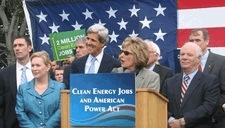
Senator Barbara Boxer (D-CA) stands at a podium to announce the Kerry-Boxer bill on climate change. (Courtesy of: Environment and Public Works)
YOUNG: From the Jennifer and Ted Stanley studios in Somerville, Massachusetts, this is Living on Earth. I’m Jeff Young.
CURWOOD: And I’m Steve Curwood. It was a big week for climate change in Washington, with both the US Senate and the Obama administration taking the initial steps toward controlling greenhouse gas emissions. The US Environmental Protection Agency announced it will begin regulating CO2 coming from major sources, such as power plants. That announcement came on the very day that Senate leaders unveiled a highly anticipated climate change bill.
YOUNG: That bill, from Democrats John Kerry of Massachusetts and Barbara Boxer of California, could transform energy policy for the US, and greatly influence international agreement on global warming. Senators Kerry and Boxer launched their ambitious effort with a campaign-style rally on the Capitol lawn.
[CROWD VOICES; APPLAUSE; WHISTLING]
YOUNG: There were no polar bear costumes or planet earth placards. Instead, a giant American flag for a backdrop, signs promising new jobs, and military veterans onstage with Senator Kerry.
KERRY: We are here, and we introduce this legislation because of one word: security. Economic security, energy security, national security. It is time to reinvent the way that America uses energy.
[APPLAUSE]
YOUNG: The Democrats’ new theme on climate change is clean energy can enhance American power. Republicans weren’t buying it. Here’s Tennessee Senator Lamar Alexander.
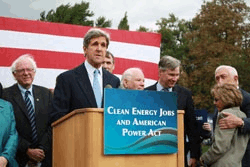
Senator John Kerry (D-MA) announces the Kerry-Boxer bill on climate change.(Courtesy of Senator John Kerry's Office)
ALEXANDER: These are fancy complicated words for high cost energy that will send jobs overseas looking for cheap energy.
YOUNG: Regardless of party, senators from states that depend most on coal, oil and heavy industry are nervous about the cost of shifting from fossil fuels. Kerry and Boxer propose a cap and trade system, as did a similar bill narrowly passed by the House in June. The senators set a more aggressive target for reducing emissions—a 20 percent cut by 2020.
And they say that can come without sharp cost increases. I spoke with Senator Boxer as she huddled with staffers in her office. She explained a new proposal in the bill called a price collar. The goal is to ensure that the cost of emitting CO2 doesn’t go too high or too low.
BOXER: We don’t want to have a price spike that makes this very, very difficult. So, as you well know, the House bill had an $11 floor on the price of carbon. And we said at $28, we will unleash the reserve of allowances we have, which will act as a mechanism to keep that price at $28. So, we call this a soft collar. We think it will take away the argument that this is gonna somehow start a huge spike in energy costs. It’s a new proposal that really was taken from best of all the cost containment proposals we looked at.
YOUNG: What else might you have to do to meet concerns that have been raised by your fellow Democrats from Midwestern manufacturing states?
BOXER: We’re working very closely with all our colleagues: some think the bill’s too weak, some think the bill’s too strong, some think the bill is just right. You know, so we clearly want to make sure consumers are kept whole, and we believe if we do this bill there’s gonna be a whole new platform for economic growth in this country. America will be the leader - it will lead to more jobs, not fewer jobs.
YOUNG: As Senator Boxer leads the bill through her Environment Committee she must also keep in mind fellow Democrats, like Ohio’s Sherrod Brown. Senator Brown says Boxer’s bill should include a so-called “carbon tariff.” He doesn’t want countries like China to win out if we cut emissions and they don’t.

Senator Barbara Boxer (D-CA) stands at a podium to announce the Kerry-Boxer bill on climate change. (Courtesy of: Environment and Public works)
BROWN: If they’re not following any kind of strong environmental rules like we are, then they should pay a tariff at the border, an equalization adjustment, if you will, that reflects that cost, environmental cost, of production. Otherwise, the jobs tend to migrate to those countries with the weakest environmental rules.
YOUNG: The House bill included a ‘carbon tariff’ and that’s been highly controversial. It might violate World Trade Organization rules. Chinese officials warned of a trade war. And that could throw a wrench into international climate talks coming in December in Copenhagen.
[ECHOING VOICES IN HALLWAY]
YOUNG: I caught up with Senator Kerry in the Senate halls. Kerry chairs the Foreign Relations Committee and has an eye on the progress toward an international agreement. He told me he thinks some sort of carbon tariff is appropriate, if done correctly.
KERRY: It is absurd to have a country think that it can just go outside of an environmental international agreement and take advantage of selling products that are high carbon content, and we should not allow that.
YOUNG: Does that complicate getting agreement with the Chinese, though?
KERRY: Well, we’re making progress with the Chinese. Hu Jintao stood up at the UN and talked about percentage reductions. The President’s going to China in November. So, we just have to now negotiate through how do you measure, how do you verify. I think that’s achievable, personally. And one thing that will really help it be achievable – I know this from our conversations – is our moving here. If we do this, you stand a better chance of getting the Chinese to be more declarative.
YOUNG: And if you don’t pass this?
KERRY Well, I think, if it actually failed, I think that would be very injurious to the Copenhagen process. I think it would be very injurious to our foreign policy, because a lot of countries held against us walk away from Kyoto and, if we were to walk away from this, I think it would be very damaging to President Obama’s foreign policy.
YOUNG: There’s more from Senators Kerry and Boxer at our website loe dot org – and, Steve, Senator Kerry says he does not think the Senate has to complete this bill before the Copenhagen gathering. He says so long as there’s good progress — say having it approved by the important committees in the Senate— then that should send a strong enough signal to other world leaders.
Related links:
- To hear an interview with Senator Boxer click here
- To hear an interview with Senator Kerry click here
- To hear an interview with Senator Brown click here
- You can read the entire Kerry-Boxer bill, or a summary, at Sen. Kerry’s site
Mercury Rising
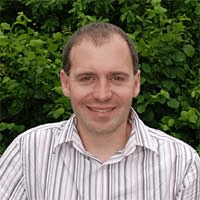
Dr. Richard Betts, Director of the Climate Impacts Group at the UK's Meteorological Office.
CURWOOD: And Jeff, to add urgency in this critical time before Copenhagen, the British Government’s scientists have just released some new research. It shows that unless we slash emissions, we could face climate disaster sooner than previously thought—perhaps within 50 years.
Dr. Richard Betts is head of the Climate Impacts Group at the UK Meteorological Office, which has perhaps the best record in global warming modeling. Dr. Betts, now it looks like your report says that world temperatures could shoot up some four degrees Celsius-- that’s seven or so degrees Fahrenheit. Am I reading your graphs correctly?
BETTS: Yes, that's what we say in our report. Our best estimate taking into account all the different models we have available would be that we could reach four degrees warming by the 2070’s, if we continue to be burning fossil fuels at a high rate. It’s important to stress that we still could avoid that if we cut fossil fuel emissions.
Say, if we don’t burn so much coal and oil, but the uncertainties are huge when you’re trying to look so far ahead in such a complex thing as the world’s climate and the absolute worst-case scenario does seem to be reaching four degrees global warming by 2060.
CURWOOD: We’re talking about a four-degree rise, or even a two-degree rise. It doesn’t sound like much, why should people be concerned about this?
BETTS: A four-degree rise globally would actually mean a greater rise in many regions, up to ten degrees in some land regions; so many countries could see a ten-degree rise. The Arctic Ocean could see perhaps a 15-degree rise. And we could see more droughts on the one hand, more floods on the other hand, and implications for food security and human health. So, a very different world, which we may find very difficult to live in.
CURWOOD: Now, as I understand it, rainfall, you project could decrease by as much as 20 percent in certain areas, but it could also go up by as much as 20 percent in other areas. Which areas are you talking about and why such a wide variation?
BETTS: So, in places such as eastern Africa, or India, or parts of southern Asia, we could actually see an increase in rainfall of 20 percent or more. It all depends on the way the global wind patterns change in response to a warming world. So, that’s why you get some areas with increased rainfall, some areas with decreased rainfall.
CURWOOD: Folks in the Philippines recently saw quite a bit of rain – are we likely to see more of this in the future? Is that what you’re saying?
BETTS: We are, and that is because on the whole we expect intense rainfall events to become more intense. The warming of the land surface, all the ocean surface, tends to drive greater thunderstorm activity, for example, which would then mean more intense rainfall. So, a warmer world on the whole means more intense rainfall events.
CURWOOD: Well let’s turn now to the chief Climate negotiator for the Philippines, Senator Heherson Alvarez who’s at the UN Climate talks in Bangkok, right now. Senator Alvarez – we’re sorry for the tragedy of this typhoon season that has been so tough for your land and people.

Dr. Richard Betts Director of the Climate Impacts Group at the UK's Meteorological Office.
ALVAREZ: Many of our people are demoralized because a great part of the island has been, since time in the world as far as they can remember, reachable by typhoons. But, these were gentle typhoons. They blow through towns, but population survived, but this time, they have become very destructive because they bring in massive volume of floodwater.
CURWOOD: What would a warmer world mean for the Philippines?
ALVAREZ: 60 percent of our best cities, or infrastructure, or industries would be under salt water. We may be forced to live on top of mountains. It’s a blessing in disguise that we are here at conference when this hit the country, so the suffering, the ruin, the pain of people and children that perished may not have been in vain because of this. If people all over the world were to understand the destructiveness of nature, I know that humanity would rise. I don’t see any reason why we do not mobilize population to be able to moderate and avert, ultimately, this destructive force.
CURWOOD: Senator Heherson Alvarez is the chief climate negotiator for the Philippines. And now turning back to Richard Betts of the UK Met office – so in the climate negotiations, the Europeans are pushing for cuts in emissions to what – 30 percent below 2005 levels? And, China is hinting that perhaps they could level off their emissions by the year 2030. If that’s the deal, could it avert the scenario that you’ve laid out?
BETTS: If we can peak emissions, say by the 2030’s, then have it decline afterwards, then that still leaves us with a change of avoiding a four-degree warming. Obviously, a lot of people are more concerned with avoiding a two-degree warming; which again we know would have significant impacts. So, to avoid a two-degree warming we need to have a peak in emissions, and cutting emissions after that, within the next ten years.
CURWOOD: So, what do you tell your grandchildren?
BETTS: Well, I don’t have grandchildren myself yet, but I tell my children that the world could be very different, in fact the world already is going to be different because we are already committed to some level of climate change, whatever we do.
CURWOOD: So, what do you ask your children to do in light of this? Do they have to take shorter showers, do they have to walk more, turn down the heat – anything like that?
BETTS: I encourage them to look beyond just individual things. I mean the things you mentioned are all appropriate measures in themselves, but also you need to see the bigger picture and be aware everything you do has some effect through your use of energy in all its forms. Whether it’s where you get your food from, what form of transport you take, how much stuff you buy in the shops – everything you buy need to be made, and that requires energy. Are we using the land in the most efficient way, especially with the growing population? So, thinking about your impact on the world in every part of your life is an important thing to do these days.
CURWOOD: Richard Betts directs the Climate Impacts section of the MET office at the Hadley Center in the UK. Thank you so much, Dr. Betts.
BETTS: Cheers, thank you.
Related links:
- Visit the MET Office’s website here
- To learn more about the MET Office’s study, view Dr. Betts’ slides here
[MUSIC: Bombay Dub Orchestra “Map Of Dusk” from ‘3 Cities’ (Six Degrees - 2009)]
YOUNG: Well, coming up, using the courts to cut CO2. Keep listening to Living on Earth!
A New Way to Tackle Carbon Emissions
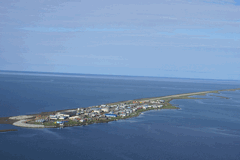
The 400 people living in Kivalina, Alaska are in danger of losing their home to the rising sea. The Second Circuit Court decision equips them to sue green house gas emitting power companies for damages. (Coast Guard photo/ Lt. Cdr. Micheal McNeil)
YOUNG: It’s Living on Earth. I’m Jeff Young.
CURWOOD: And I’m Steve Curwood. The Second US Circuit Court of Appeals has opened the door for states and even private citizens to sue coal-fired power plants and other major emitters of global warming gases. The decision, which is predicated on the grounds that greenhouse gases may be a public nuisance, came in a case called the State of Connecticut versus American Electric Power. Patrick Parenteau is a professor at Vermont Law School. Professor Parenteau told us the ruling could prove to have a major impact.
PARENTEAU: The remarkable thing is that the second circuit said this is just another tort-type case. It’s a big one, of course, and it’s loaded with complicated science questions, and cause-and-effect questions, but at bottom it is a tort case.
CURWOOD: And, quickly, for those of use who didn’t get to go to law school, what’s the shorthand definition of tort?
PARENTEAU: Tort is civil wrong, it’s the kind of thing where someone runs a stop sign and runs into your car. It’s an everyday occurrence in courts all across the country. Medical malpractice, of course very controversial these days in light of health care, is a large area of tort law.
CURWOOD: So, in the wake of this decision, who now then has the right to bring a lawsuit against a company emitting greenhouse gasses?
PARENTEAU: Yes, the court ruled that not only do states have the right to bring these actions, but most interesting, private parties, and specifically land trusts that own, for example, property in the coastal zone threatened by sea-level rise – they, too, have standing to bring public nuisance actions, and that’s quite remarkable.
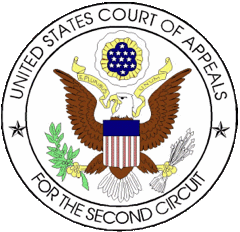
The Second Circuit Court of Appeals is the third highest court in the land.
CURWOOD: Now, what impact will this decision have on let’s say the case of the Alaskan village of Kivalina, who filed suit last year against the power companies for greenhouse gas emissions. What will they be able to do in light of this ruling?
PARENTEAU: That’s going to have a significant effect. The second circuit is a very well regarded court of appeal, it’s probably – if you were thinking of ranking – it’s probably ranks third of all the courts in the land, with the Supreme Court being first and the D.C. circuit being second. So, it’s going to have an impact on the Kivalina case, which is pending in the district court in northern California to determine whether or not the damage being done to the village of Kivalina, which, of course, is literally – the island it’s on is disintegrating into the Arctic Sea and is going to have to be relocated. And, so this decision opens the door, I think, for the Kivalina case to proceed to trail.
CURWOOD: So, at the end of the day, what are the political effects of this ruling? I mean, right now we have Congress moving toward a climate legislation, there was an earlier Supreme Court decision that allowed the EPA to consider carbon dioxide – the global-warming gas – as a pollutant, and can therefore move toward cars and trucks that emit CO2; what are the political effects of this ruling?
PARENTEAU: I think the political effects may be some of the most important ones. The court was very careful to say, unless and until either the Environmental Protection Agency adopts specific regulations to control greenhouse gasses, or Congress acts to enact a comprehensive climate change bill, the courts are open to hear these cases and perhaps, at some point, hand down a verdict against some of these industrial sources. So, it’s interesting, it’s another indication of the judicial branch putting pressure, in effect, on the other branches of government.

The 400 people living in Kivalina, Alaska are in danger of losing their home to the rising sea. The Second Circuit Court decision equips them to sue green house gas emitting power companies for damages. (Coast Guard photo/ Lt. Cdr. Micheal McNeil)
CURWOOD: You say that this is a catalyst for the other branches of government; what would happen if the courts continued to be involved in these global warming gas cases, and say, Congress and the Executive didn’t do anything?
PARENTEAU: Well, in the Connecticut case, the second circuit case, the states are seeking a remedy that would, in effect, be a cap on the emissions of the specific power plants that they’ve sued, the largest one being the American Electric Power Company, which is the largest utility in the country with the most number of coal-fired power plants.
So, what this decision is saying is if the states are able to establish liability after a trial, in other words, if they are able to connect the emissions from these sources to impacts in Connecticut and other states, then the courts are going to order the utilities to start limiting the amount of emissions. And that kind of remedy scares the industry greatly. In fact, one of the other effects of this decision is gonna be impacts on their stockholders and their financial institutions that support them because this now opens the doors to liability and they’ll have to report that risk of liability to the Securities and Exchange Commission and other institutions.
So, it has a lot of different ripple effects, and as the industries react to the potential for liability, I would anticipate the pressure on Congress to act and protect the industries from this kind of liability will also increase.
CURWOOD: Some people are comparing these greenhouse gas court cases to the tobacco litigation. How fair a comparison is that?
PARENTEAU: Well, in the Kivalina case, one of the claims made is that the defendant companies, and that includes utilities and coal companies, conspired to mislead the public in the…and the legislative branch, on the dangers of climate change, which means that they could put the oil and coal companies under oath the same way the tobacco companies were put under oath in the tobacco cases.
And they’d have to answer questions about, did you in fact fund studies that claimed that climate change was not real, and did you put out public announcements, and in effect, propaganda that was you knew to be false, or at least misleading? And when the plaintiffs in these cases are able to prove a conspiracy, the courts are much more likely to assign liability to those corporations as a consequence of those overt acts of misleading the public.
CURWOOD: Would they have to put warning labels on the products that they sell?
PARENTEAU: [laughs] Well, we aren’t at that point yet…
CURWOOD: Patrick Parenteau directs the Environment and Natural Resources Law Clinic at the Vermont Law School. Thank you so much, Professor Parenteau.
PARENTEAU: My pleasure, Steve.
Related link:
The 2nd circuit court's decision may spur action from the other branches of government.
[MUSIC: J Boogie “Golden Nectar” from ‘J Boogie’s Dubtronic Science’ (Om Records - 2003)]
River Resurrection
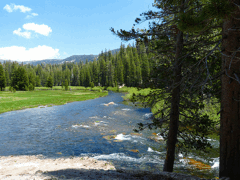
Middle Fork of the San Joaquin River
YOUNG: California’s second-longest river, the San Joaquin, once flowed from the Sierra Nevada through the fertile Central Valley to San Francisco Bay. But for the past 40 years, dams and diversions for farming caused long stretches to run dry. Now, new public lands’ legislation brought a small gush of water from Friant Dam, to the cheers of environmentalists. Monty Schmitt of the National Resources Defense Council believes this will help the people and the ecology of San Joaquin Valley, especially the Chinook salmon.
SCHMITT: Currently, over 60 miles of that river dry up, so in the future – in the very near future – we will have flows year-round, always connecting the river all the way to the sea. This is the second year that the commercial salmon fishery has been closed down, and while there’s a lot of reasons why the populations have been crashing, restoring the San Joaquin River is truly one of the best and most important things that can be done in the near term to help restore that fishery and to bring the commercial salmon industry back to health.

Middle Fork of the San Joaquin River (http://www.flickr.com/photos/california_dreamin_77/3903363711/)
CURWOOD: The River may be only a tiny trickle of water as of yet, but the legislation is making big waves in the agricultural community. Kole Upton says that farmers like him are used to adversity, but the loss of irrigation is a steep price for a project that given the threats from widespread sewage pollution and a warming climate may not even save the salmon….
UPTON: What we’re looking at in our area is probably 15 to 20 percent of the land will just go out of business in order to balance the water that we have with what we’re going to get. The politicians and the government agencies say, well, we just need more and more water from the valley to clean up the delta. They can take every drop from us here in the Central Valley and it’s not going to clean up that delta until they address the other issues that are causing the decline in the species. I mean, I applaud the effort -- right now, I’m just afraid that we’re going to spend a lot of money and run a lot of people out of business, and fail in the process.
Desert Water Keeper
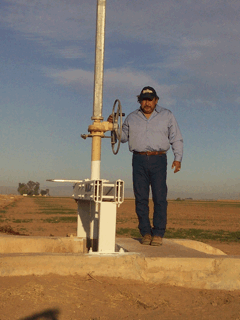
Photo: Ingrid Lobet
YOUNG: When irrigation water eventually does reach the agricultural areas of America’s West, it still needs to be channeled into farmers’ fields. And that’s the task of a zanjero, a person who controls the irrigation canals to bring the vital water to croplands. In southern California, manmade rivers carry the water all the way from the snowmelt-filled Colorado River…. to the hottest, windiest fields of the Imperial Valley desert. Living On Earth's Ingrid Lobet drove with one zanjero along the concrete channels, as he sprang in and out of his truck opening and closing gates, fulfilling farmers' daily orders for water.
[SOUND OF GATE BAR; OPENING GATE]
ROMO: My name is Jose Romo, and I'm a zanjero.
[WATER FLOWING INTO IRRIGATION CANAL]
ROMO: Zanjeros, ditch-tender… it depends on what part of the country you're from. But everybody has a zanjero. Anywhere you run water; there’s somebody that has to actually control it, because the water doesn't deliver itself.
[SPLASHING WATER; CLANKING METAL; TRUCK DOOR CLOSES; DRIVING SOUNDS]
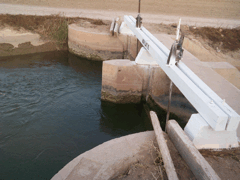
Photo: Ingrid Lobet
ROMO: I love the work. Tradition, yes there is a lot of tradition to it. When they first started to do this, they used to do it on horseback.
[TRUCK RUMBLING]
ROMO: You rarely every see a farmer, the owner himself out here. You're dealing with the employees, the foremen, the irrigators, the tractor drivers.
ROMO: Let's see, I gotta make a delivery right here.
[DOOR OPEN; CAR BEEPING]
ROMO: ¡Buenos dias! Cinco pies, doce horas!… ¿Ud. la abre o yo la abro? Ud. la abre por favor.
[METAL CLANKING; OPENING GATE; LOUD, FLOWING WATER]
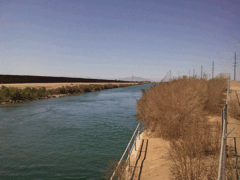
Photo: Ingrid Lobet
ROMO: They're going to be watering germination broccoli with a pump. They are priming it right now; they’re starting to prime the pump.
[TRACTOR SOUNDS]
ROMO: This is what the whole purpose of our job is - to make sure that the water comes down here, that he can water confidently for 24 hour period, 12 hour period, whatever he needs in order to get that crop germination going.
[ENGINE IDLING]
[AGUSTIN SPEAKING SPANISH]
VOICEOVER: It's crucial, since we're doing broccoli seedlings. If the water comes up just one day late, these seedlings would wither. Fortunately, we're never short of water. And today we're running at full bore.
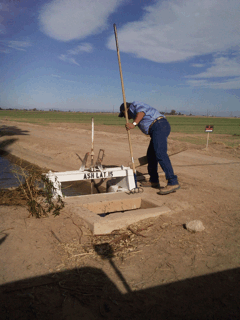
Photo: Ingrid Lobet
ROMO: They want to hit that window when they plant that crop and harvest that crop, when there is not that much of that particular crop being offered. If they hit that window, they can make a lot more money than let's just say if everybody's crop matures at the same point.
ROMO: Here in the Imperial Valley, it varies but it can get to 117, 118 at times. And it's intense heat. On the average in the winters, the 70s, occasionally you'll go down to freezing at night. But that's kind of rare now. Now, the winters are not as severe.
[GATE CLOSES; CLANKING METAL; TRUCK DOOR OPENS AND CLOSES; DRIVING SOUNDS]
ROMO: You deal with a lot of issues out here.

Photo: Ingrid Lobet
ROMO: They'll take the diesel fuel that powers the motor… that's been stolen before. They'll take the anhydrous ammonia that you use to fertilize your crops. They'll use that for manufacturing of crystal. There is a lot of things going on here. Just in my area alone, I have found four or five labs, you know the residue anyway, what you're left with.
ROMO: The first time I ran into a lab I didn’t even know what I was dealing with. But then you start putting things together. You're talking about ether, you're talking about batteries, you’re talking about different types of acid. Then they come out here; it's an isolated area, usually no one around, and they manufacture a batch and then dump the residue right here where it's at.
[CAR PASSING]
ROMO: I have found so many different things in these canals. It would amaze you. I have found washing machines, driers, bowling balls, briefcases, vehicles, of course, animals. I found a 20 foot old wooden boat [laughing] that somebody threw in the canal because they didn't want take it to the dump. Everyday, you just don't know what you are going to find.
ROMO: Lately, what we’re starting to find, or have found recently in the last five years, are backpacks that illegal aliens either drop or lose. And then you find all their clothes or basically everything they had on their back…
[TRUCK STOPS; DOOR BEEPING WHILE OPEN; HOWLING DOG; RUSHING WATER]

Photo: Ingrid Lobet
ROMO: I' m going to turn this pond loose – I’m gonna use this water down below for another order for today. This guy is finished. He got started at 9 a.m. yesterday and he's finishing up at 8, so basically he only ran 23 hours. But he is done with his water.
[SQUEAKING AND RATCHETING METAL; WATER SOUNDS STOP; TRUCK DOOR CLOSES; DRIVING SOUNDS]
ROMO: I like oldies, heavy metal, hard rock, country western, old style ranchera music from the Spanish stations… Here is the one out of Mexicali, they play the old rock, there is the heavy rock out of Palms Springs, that is 97.7 KPBS, that is my country western out of Yuma, and that is another station out of Yuma.
[COUNTRY ROCK AND ROLL MUSIC]
ROMO: When I was hired, the majority of the people were from Oklahoma, Arkansas, Missouri. Very few Mexicans, Mexican-Americans worked as Zanjeros. Racism? To a certain extent, yes. The Imperial Valley you have to remember is farming; it is close to the border, I mean it is not, "hey, you know, you screwed me up," it is, "you dumb Mexican, you screwed me up." It doesn’t happen as often because you're dealing with a different generation nowadays, but it still exists.
ROMO: Used to be a lot of Japanese down here. I didn't hear that from most of the history books, but my Dad told me there was a lot of Japanese that had a lot of ground, a lot of orchard. And when they got interned in the internment camps, their ground was taken away and sold. But the Valley has a lot of makeup of a lot of people.
[TRUCK AND ROAD SOUNDS]
ROMO: The district still has a plenty of water right now, but down the road I think we are going to see situations like in LA where you are going to be limited to the amount of water you can apply to your fields. It just hasn't reached that level yet here in the Imperial Valley, but it is around the corner.
[TRUCK STOPS; DOORS OPEN; SOUND OF MOVING WATER]
ROMO: The sound of the water is very relaxing. At times when I'm stressed out, I'll just stop and I’ll listen to the water: the different sound levels, different pitches. I like it. I enjoy my job.
[SOUND OF WATER SPLASHING AND BOUNCING IN CANAL]
CURWOOD: Jose Romo has delivered water to farmers in California’s Imperial Irrigation District for 34 years. This profile was produced by Living on Earth’s Ingrid Lobet.
[MUSIC: Carlos Santana “Curacion (Sunlight On Water)” from ‘Multidimensional Warrior’ (Legacy Records - 2008)]
CURWOOD: Just ahead, a birdbrain, who is also a genius. Stay with us on Living on Earth!
ANNOUNCER: Support for the environmental health desk at Living On Earth comes from the Cedar Tree Foundation. Support also comes from the Richard and Rhoda Goldman fund for coverage of population and the environment. And from Gilman Ordway for coverage of conservation and environmental change. This is Living On Earth on PRI, Public Radio International.
Science Note/ Slime Mold
YOUNG: It’s Living on Earth. I’m Jeff Young.
CURWOOD: And I’m Steve Curwood. Just ahead, just why do birds of a feather flock together? But first, this note on emerging science from Quincy Campbell.
[STAR TREK THEME MUSIC]
New research about slime mold brings the realm of science fiction closer to science fact.
Scientists at the University of West England in the United Kingdon are developing a robot made of slime mold. In other words, these organisms are being programmed to move about!
[SCIENCE NOTE THEME]
The robot’s name is “Plasmobot”, which refers to the plasmodium of the slime mold – the spreading, web-like structure made of many unicellular creatures that move around as one. Slime molds are already known for their ability to seek out nutrients and move around obstacles, as well as transport objects. Now scientists are hooking the slime mold’s super-sensory smarts up to a computer.
Just like other robots, the plasmobot will be able to solve sophisticated tasks, like finding the shortest distance around an obstacle. This globular, fully-biological robot challenges conventional notions about computers, but it might also revolutionize medicine. Researchers say we may one day use nano versions of the plasmobot to perform treatments in the human body, such as targeted drug delivery. Their work blurs the line between artificial and biological intelligence, at the frontier of science where no man has gone before.
[PICARD/BORG: “RESISTANCE IS FUTILE”]
That’s this week’s note on emerging science. I’m Quincy Campbell.
Bird Genius
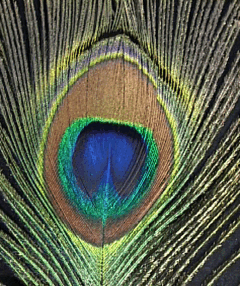
Pavo cristatus is the Peacock
YOUNG: Some 46 million people in this country say they are birdwatchers. But not many watch birds quite the way Richard Prum does. Prum’s an ornithologist at Yale who looks closely—microscopically closely—at bird feathers. That’s revealed profound insight into just how birds got their amazing variety of colors. Dr. Prum’s work was recognized last month by the MacArthur Foundation—he received one of their prestigious awards, sometimes called the MacArthur genius grants. Dr. Prum, why feathers?
PRUM: Well, I have been a life-long bird watcher and bird nut, frankly. And through teaching ornithology over the years, I became increasingly interested in feathers, themselves. First, I just thought this is a fundamental aspect of avian biology that I ought to know about, and I found that there was surprisingly little modern literature on feathers and that there were great research opportunities, great unanswered questions. That is what led me into this sort of feather mania stage of my career.
YOUNG: And specifically, you’re studying feather colors, right?
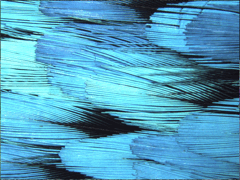
Cotinga cayana is Spangled Cotinga from the Amazon
PRUM: We have studied just about everything about feathers that we can fit into time. In particular, we’ve been studying structural colors, which are colors that are made by interaction of light with the material of the feather, itself. These include blue jays, or bluebirds, or hummingbirds, and these are colors that, like the anti-fraud holograms on your credit cards, are the result of light bouncing off of a material object, in this case air bubbles or pigment granules in the feathers themselves. And, actually there’s some interest in technologies, in trying to develop new technologies that work the way bird feathers do.
YOUNG: And, you know, here we are, just on the verge of tapping into nano-scale technology – birds have been using it for a long time.
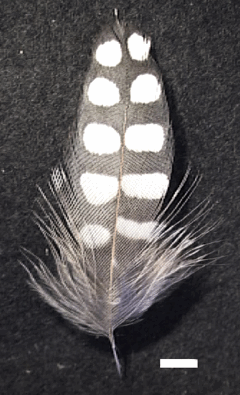
Crytonyx is Montezuma Quail from the Sonoran and Chihuahuan deserts
PRUM: Yeah, and that’s what’s fascinating that there is a lot interest in the field of engineering and technology to look at biomimetic materials, biomimetic solutions to physical problems. Interestingly, birds, through their desire or their needs to communicate with one another have evolved all sorts of nano-scale solutions to do so.
And exploring that may give a guide to how technologies can be developed. Of course, my interest is basically, with the birds. [Laughs] Although I’m fascinated by the technology development possibilities, for me this is all an excuse to know more about birds, how they work, and the lives of birds. Birds have beautifully rich color vision, much richer than ours, much more complicated, and they see in four colors rather than just the three that we know. So we have red, green, and blue, but birds have red, green, blue, and ultra-violet or violet; another short wavelength color detector in the eye.
YOUNG: Wow, so as vivid and striking as birds are to our eyes, it’s even more so through a bird’s eyes?
PRUM: Correct, what that means is that birds have an extra dimension to their color vision. So bird have these colors like ultra-violet plus yellow, which is a strange form of purple that we can’t even imagine, right? And they can see these, they use them in their communication, so their color world and their color experience is much richer than ours.
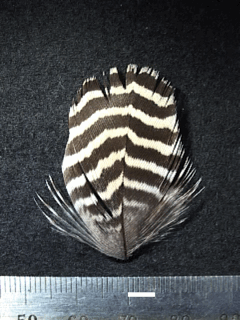
Eupodotis atra is a Little Black Bustard from southern Africa
YOUNG: You’ve been looking into some very old fossils – 47 million-year-old fossil, I read, that actually had some colored feathers on it.
PRUM: Last year we discovered that these little, oblong, tiny, tiny structures that people had thought were bacteria in fossil feathers turned out to be melanasomes or melanin granules, so people hypothesize that these structures were the bacteria that ate the feather when it was being deposited or fossilized, but in fact, it turned out that they were the sort of cellular organelles that include melanin pigments. So, they were direct fossil evidence of the melanin that was in the feather, in the living bird.
YOUNG: So, you know what color that thing was?
PRUM: We are beginning to reconstruct that. The first cases, of course, we’re finding when there’s lots of melanin we’re finding that the feathers look blackish or were likely to have been dark black. But, in the case of this recent discovery, we found a feather that was likely producing a structural color, sort of like a starling or a grackle – were the bird itself if dark blackish, but has an oily or metallic sheen on its plumage either copper-colored, or greenish, or deep blue.
YOUNG: So, if you continue working backwards that way, is it possible to learn more about what color dinosaurs might have been?
PRUM: Exactly, and we’re eagerly pursuing that topic right now.
YOUNG: You realize you’re going to have to, you know, redraw, reprint every kid’s dinosaur coloring book that ever came out. [Laughs]
PRUM: Right, right, but I’ve been on this line for a while. Back in, oh, I think it was 1999 or 2000 when I went to a meeting and saw some of the feathered dinosaur fossils from China for the first time. I came back and I lined my kids up on the couch and I said, guys, I want you to remember something. I want you to know that T-rex had feathers. And they said, no, no, Dad! T-rex doesn’t have feathers. And I said, no it does, and the reason we think T-rex had feathers is because the phylogenetic, or the tree of relationships indicates that Tyrannosaurus rex was inside of a group that we know now from fossil evidence had feathers. We’ll have to redraw and re-conceive of lots of aspects of dinosaur biology once we make additional discoveries like these.
YOUNG: Putting some skin, some flesh, and in some cases some feathers on those bones we’re all familiar with in museums…

Pavo cristatus is the Peacock
PRUM: I’m certainly counting on the fact that some day you will download, or buy, or purchase a special deluxe edition of “Jurassic Park” where you can toggle through the menus and you can request that the appropriate skin coverings be placed on each of those organisms. And you can see those things re-rendered as they are supposed to be based on modern science.
YOUNG: So, what are you going to do now? You have this prestigious award from the MacArthur Foundation, plus doesn’t hurt getting half a million bucks, I guess. What now?
PRUM: In particular, I’m interested in aesthetics, the connection between the sexual selection as it occurs in birds, and bird plumage, and bird song and the arts, generally, or what we understand as the arts. So that’s pretty out there, and that’s a new topic that I’m working on right now.
YOUNG: Now, wait a minute, you’re talking about why we find something attractive or beautiful?
PRUM: Yeah, I’m talking about the commonalities between the process of the evolution of ornament in nature and the similar sort of aesthetic process that we see in human arts and whether or not those processes are a lot more similar than we realize.
YOUNG: Well, if you’re gonna do that, that requires working pretty far outside the bounds of what most people would consider standard ornithology, but you’re already doing a lot of that, so you’re not afraid to team with people from all sorts of fields of study.
PRUM: Over the years, I’ve become pretty much addicted to doing things that are outside of what I’ve done before. I think that the field or ornithology, or I pursue the field of ornithology, as if it were avian area studies. And that’s how I work, and sometimes it includes physics, and sometimes it includes physiology, or behavior or evolutionary biology, or sensory biology – all these different areas. I think that this is a modern way to look at what’s usually kind of a dusty category.
YOUNG: Dr. Richard Prum is an ornithologist at Yale University, a curator at the Peabody Museum of Natural History, and a recent recipient of the MacArthur Foundation award, which makes him officially a genius. Thanks very much for your time, sir.
PRUM: Thank you.
Related link:
Richard Prum's bio
[MUSIC: Azymuth “Light As A Feather” from ‘Light As A Feather’ (Celestial Harmonies - 1979)]
Tornado of Birds
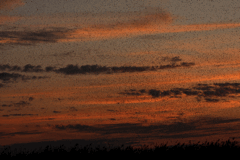
Tree Swallows fill the sky (Photo: Noble Proctor)
CURWOOD: The tidal marshes of the lower Connecticut River that feed into Long Island Sound are popular spots for migrating birds to rest up, feed, or spend the night. Producer Laurie Sanders went to one of these marshes to witness one of the most spectacular – yet little known – events on the Eastern flyway.
[BOAT ENGINE SOUNDS]
SANDERS: It is about 6 o’clock, dinner time, as we head out into the marshes of the Connecticut River. We’re in Old Lyme, in Lord’s Cove, about half a mile from Long Island Sound. It’s low tide right now, and the exposed mudflats and extensive shallows are perfect feeding grounds for herons, sandpipers and other shorebirds. The water is mirror still, and in the intense, angled light of the late afternoon, the marsh plants look like they’re glowing.
PROCTOR: So we just watch the edges here for Least Bitterns and Sora Rails.
SANDERS: That’s Noble Proctor, one of Connecticut ’s best birders and all-around naturalists. His friend and fellow-birdwatcher Hank Golet is at the wheel. During the next half hour or so, the two spot lots of great birds. But as nice as those birds are, they’re not the reason we’re here. Golet jokes, they’re just the pre-show. We’re here to take in the gathering of hundreds of thousands of tree swallows - an avian event of unrivalled proportion that Golet is credited with discovering back in the mid-1970s.
GOLET: There are a few swallows over there I guess, but that’s nothing.
PROCTOR: It’s just a taste of what lies ahead. You really know it’s going to happen when you look up river and as far as you can see on the horizon, there will be black bands of swallows coming. It’s like a flood wave coming down.
SANDERS: As the sun sinks lower on the horizon, the tree swallows begin to arrive. Where there were just a few a minute ago, now there are thousands, coming from every direction.
PROCTOR: Take a look at that through the binoculars. Just look into that and see the density. It’s incredible…
GOLET: And that’s nothing yet.
PROCTOR: That’s a warm up group. They look like gnats. It’s interesting because even after doing it for 15, 16 years, I still get excited as coming down the first time.
SANDERS: Fifteen or sixteen years ago is when Proctor first came out with Golet and their mutual friend Roger Tory Peterson. Peterson has been called the John James Audubon of the 20th century. An artist, educator, and supreme naturalist, his field guide series is credited with rekindling America ’s interest in natural history.

Tree Swallows fill the sky (Photo: Noble Proctor)
PROCTOR: I mean to have Roger Peterson, who has seen half a million flamingos on a lake on one time, to come over and say this is one of the greatest ornithological phenomenon he’s ever seen, says an awful lot about what we’re about what we’re getting a chance look at.
SANDERS: Proctor and Golet remember that outing vividly. Everything worked. The weather, the swallows. Peterson would later write in Bird Watcher’s Digest, that in his entire lifetime of birding, he’d never witnessed a spectacle more dramatic than the twisting tornadoes of tree swallows, plunging down into the marsh from the sky after sundown. And he’d never known about it, even though he’d lived only a few miles away for 40 years.
[ENGINE CUTTING SOUND]
SANDERS: Golet cuts the engine. We’ve arrived at his favorite viewing spot. In front of us is a low island covered with Phragmites. This tall reed can grow 12 feet in a single season and form dense stands that for us, are virtually impenetrable. And in the lower Connecticut River, this is the largest and densest stand of Phragmites. And it’s where the tree swallows prefer to roost.
By roosting here together, the birds gain some protection. Proctor says it’s basically a numbers game. The more birds in the roost, the less likely it is that you’ll be the one that gets picked off by a Cooper’s hawk or peregrine falcon.
[CHITTERING BIRDS]
SANDERS: Now as the sunset peaks, so do the swallows. They fill the sky, from the horizon line to the clouds. Proctor estimates there are more than 100,000 tonight. By mid-October, the number will swell to more than 500,000.
PROCTOR: They’re starting to spin a little.
SANDERS: As the colors of the sunset fade, the swallows have formed a tighter and tighter mass over the marsh. Their flight has become more organized. Whirling, en masse. And then, all of sudden, responding to some unknown cue, they start diving down into the marsh.
PROCTOR: There they go, they just dropped down. The upper group is dropping out right now. Just watch them go straight over the Phragmites down low. Here comes another big group in.
SANDERS: We watch, without speaking, as this swirling mass of birds descends into the marsh before us. It is not gentle gliding. They’re plummeting into the reeds. And in five minutes, it’s over. The sky is empty of swallows, and all hundred thousand are so, are in the Phragmites. Proctor says whenever he watches the descent, he always wishes he could have a different vantage point.
PROCTOR: What I would really like to see, is I would love to be at the bottom of the vortex and see where that many go. Because the bottom of the vortex is just 100 feet across, if that.
SANDERS: There are still so many questions about this phenomenon. What initiates their descent? How do the swallows know to come here? Do they come back night after night? And, where are they coming from? Based on the fact that they can fly 25 miles an hour, Proctor guesses these birds are coming, not just from other parts of Connecticut, but also Rhode Island, Massachusetts, and definitely, flying across the Sound, from Long Island.
PROCTOR: So, what we saw tonight is stunning. But five times that is gonna appear, or even more, eight times that, so that it will be a perfect jet black V against that sunset.
SANDERS: Proctor says until you’ve seen that, you want to keep coming back. And even after you’ve seen it, you’ll want to see it again. For Living on Earth, I’m Laurie Sanders in Old Lyme, Connecticut.
[MUSIC: The Meters “Ain’t No Use” from ‘Rejuvenation’ (Atlantic Records - 2004 Reissue)]
CURWOOD: On the next Living on Earth, fishermen feeling the squeeze in the push for more offshore wind energy.
DELLINGER: There’s gonna be winners and losers in the process. I think it’s a matter of sizing the industry so that we can have a sustainable fishery and a sustainable industry to harvest those fish.
CURWOOD: Managing our crowded coasts. Next time on Living on Earth.
YOUNG: We leave you this week on the streets of Bangkok.
[VOICES TALKING; KNOCKING SOUNDS]
YOUNG: Global climate talks are under way at the United Nations building in Thailand’s capital. That’s not what on the minds of these residents in the neighborhood Sartorn – their eyes are on a rattan ball, which they kick and head butt over a net in the fast-paced Thai game called Sepak Takraw.
[PLAYING SOUNDS]
YOUNG: Living on Earth’s Mitra Taj was on the sidelines with her microphone.
[YELLING; BALL BEING HIT BACK AND FORTH]
CURWOOD: Living on Earth is produced by the World Media Foundation. Our crew includes Bobby Bascomb, Eileen Bolinsky, Bruce Gellerman, Annie Glausser, Ingrid Lobet, Helen Palmer, Jessica Ilyse Smith, Ike Sriskandarajah, and Mitra Taj, with help from Sarah Calkins, Marilyn Govoni, and Sammy Souza.
YOUNG: Our interns are Quincy Campbell and Nirja Parekh. Jeff Turton is our technical director. Alison Lirish Dean composed our themes. You can find us anytime at LOE dot org. I’m Jeff Young.
CURWOOD: And I’m Steve Curwood. Thanks for listening.
ANNOUNCER: Funding for Living On Earth comes from the National Science Foundation supporting coverage of emerging science. And Stonyfield farm, organic yogurt and smoothies. Stonyfield pays its farmers not to use artificial growth hormones on their cows. Details at Stonyfield dot com. Support also comes from you, our listeners. The Ford Foundation, The Town Creek Foundation, and The Oak Foundation supporting coverage of climate change and marine issues. The Bill and Melinda Gates foundation, dedicated to the idea that all people deserve the chance at a healthy and productive life. Information at Gates foundation dot org. And Pax World Mutual Funds, socially and environmentally sustainable investing. Pax world for tomorrow. On the web at pax world dot com.
ANNOUNCER 2: PRI – Public Radio International.
Living on Earth wants to hear from you!
Living on Earth
62 Calef Highway, Suite 212
Lee, NH 03861
Telephone: 617-287-4121
E-mail: comments@loe.org
Newsletter [Click here]
Donate to Living on Earth!
Living on Earth is an independent media program and relies entirely on contributions from listeners and institutions supporting public service. Please donate now to preserve an independent environmental voice.
NewsletterLiving on Earth offers a weekly delivery of the show's rundown to your mailbox. Sign up for our newsletter today!
 Sailors For The Sea: Be the change you want to sea.
Sailors For The Sea: Be the change you want to sea.
 The Grantham Foundation for the Protection of the Environment: Committed to protecting and improving the health of the global environment.
The Grantham Foundation for the Protection of the Environment: Committed to protecting and improving the health of the global environment.
 Contribute to Living on Earth and receive, as our gift to you, an archival print of one of Mark Seth Lender's extraordinary wildlife photographs. Follow the link to see Mark's current collection of photographs.
Contribute to Living on Earth and receive, as our gift to you, an archival print of one of Mark Seth Lender's extraordinary wildlife photographs. Follow the link to see Mark's current collection of photographs.
 Buy a signed copy of Mark Seth Lender's book Smeagull the Seagull & support Living on Earth
Buy a signed copy of Mark Seth Lender's book Smeagull the Seagull & support Living on Earth

